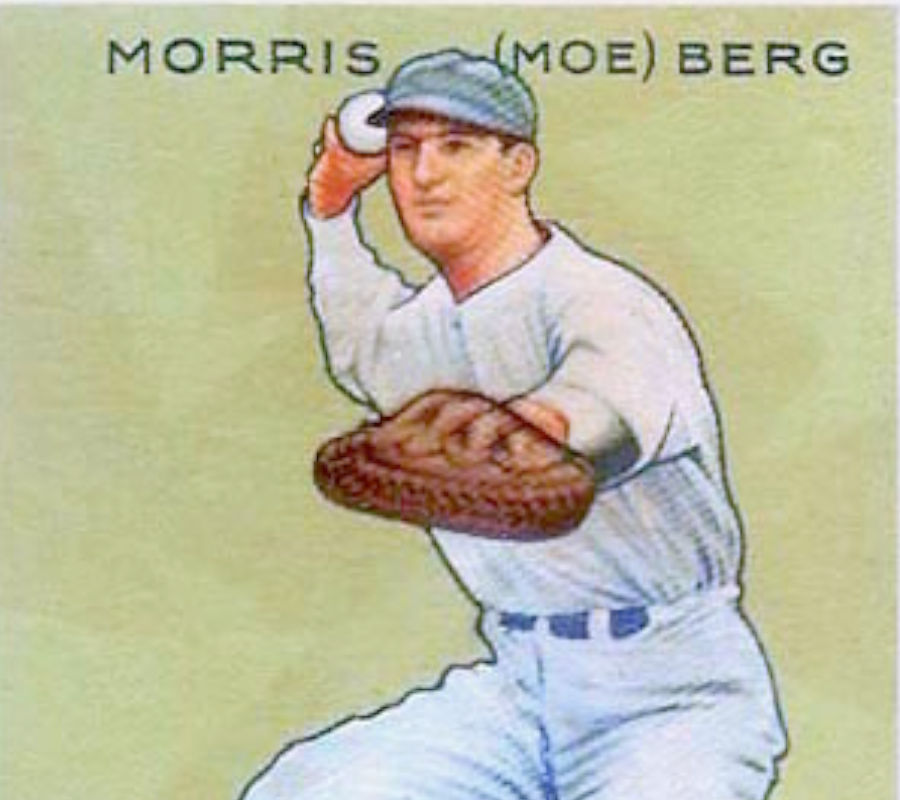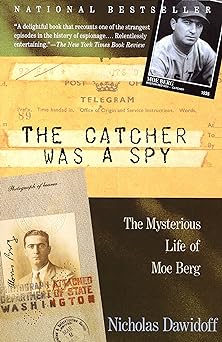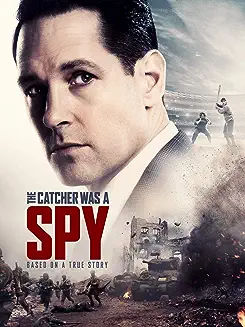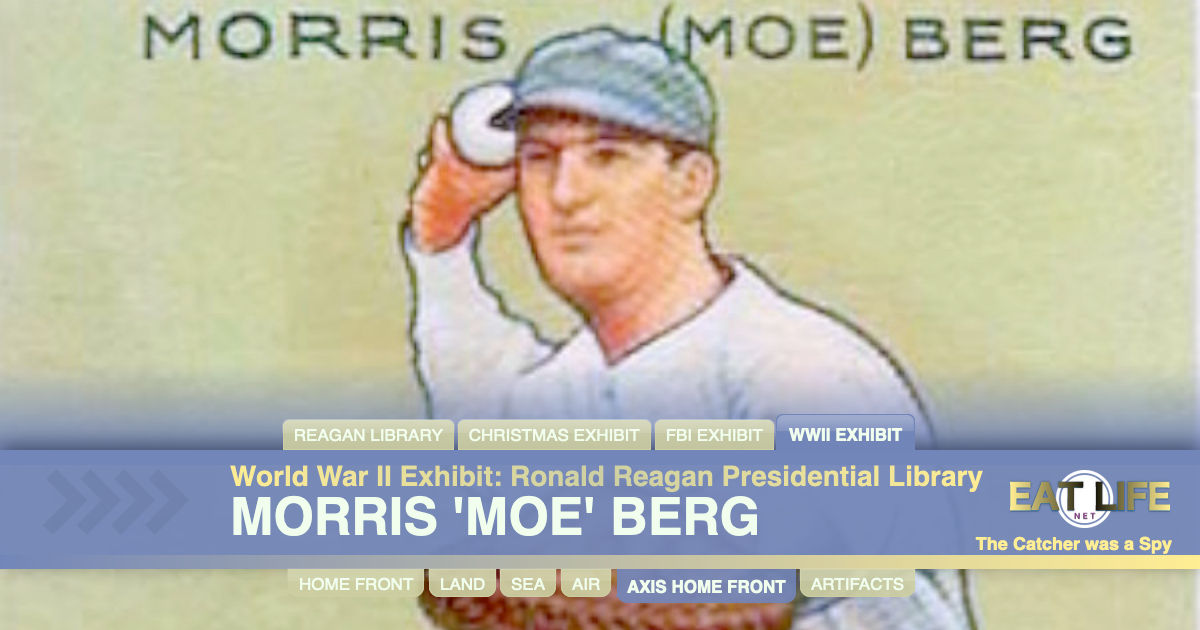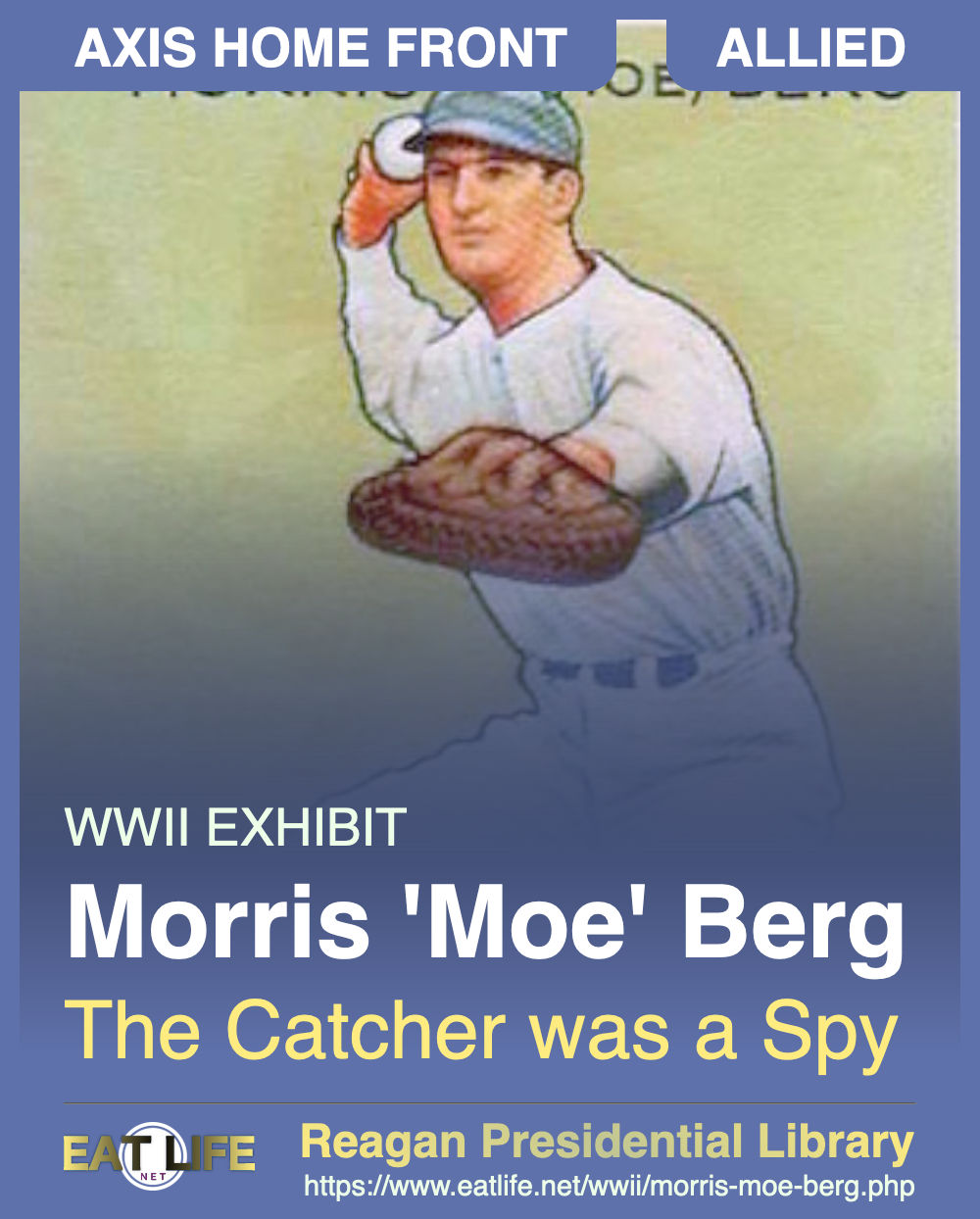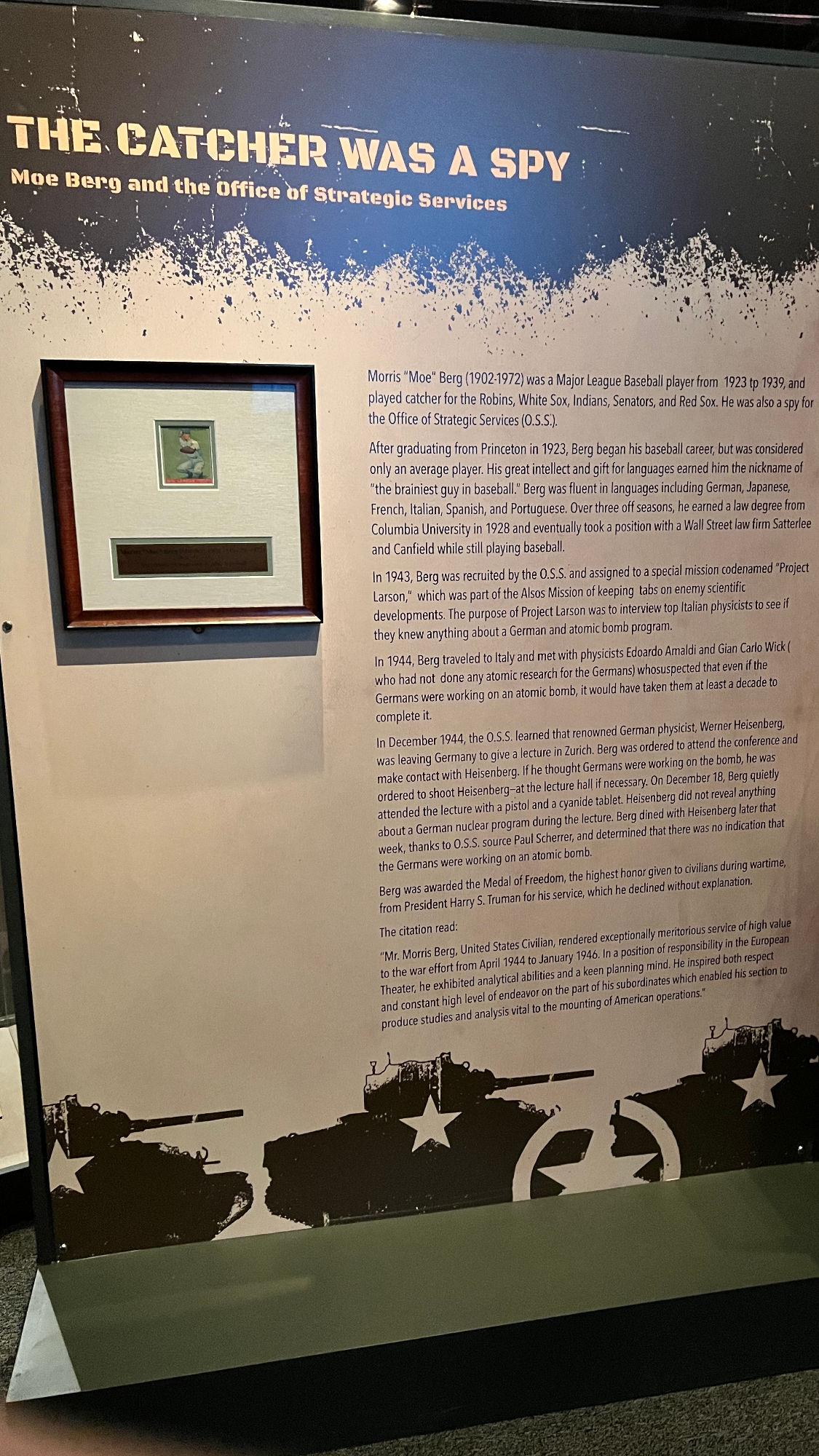
Moe Berg and the Office of Strategic Services
Morris "Moe" Berg (1902-1972) was a Major League Baseball player from 1923 to 1939, and played catcher for the Robins, White Sox, Indians, Senators, and Red Sox. He was also a spy for the Office of Strategic Services (O.S.S.).
After graduating from Princeton in 1923, Berg began his baseball career, but was considered only an average player. His great intellect and gift for languages earned him the nickname of "the brainiest guy in baseball." Berg was fluent in languages including German, Japanese, French, Italian, Spanish, and Portuguese. Over three off seasons, he earned a law degree from Columbia University in 1928 and eventually took a position with a Wall Street law firm Satterlee and Canfield while still playing baseball.
In 1943, Berg was recruited by the O.S.S. and assigned to a special mission codenamed "Project Larson," which was part of the Alsos Mission of keeping tabs on enemy scientific developments. The purpose of Project Larson was to interview top Italian physicists to see if they knew anything about a German and atomic bomb program.
In 1944, Berg traveled to Italy and met with physicists Edoardo Amaldi and Gian Carlo Wick (who had not done any atomic research for the Germans) who suspected that even if the Germans were working on an atomic bomb, it would have taken them at least a decade to complete it.
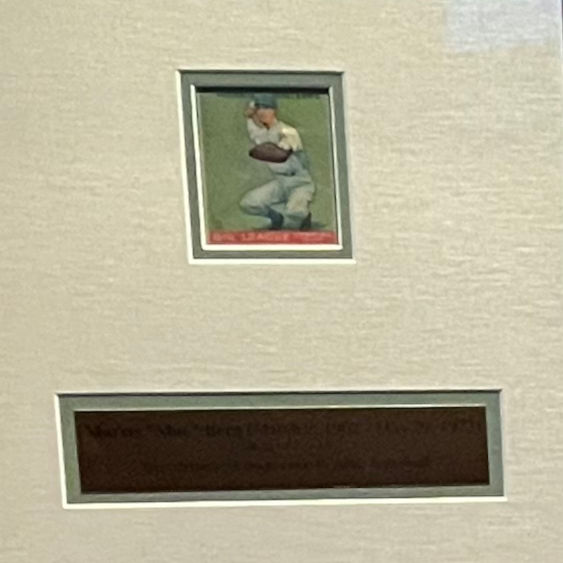 In December 1944, the O.S.S. learned that renowned German physicist, Werner Heisenberg, was leaving Germany to give a lecture in Zurich.
Berg was ordered to attend the conference and make contact with Heisenberg.
If he thought Germans were working on the bomb, he was ordered to shoot Heisenberg - at the lecture hall if necessary.
On December 18, Berg quietly attended the lecture with a pistol and a cyanide tablet.
Heisenberg did not reveal anything about a German nuclear program during the lecture.
Berg dined with Heisenberg later that week, thanks to O.S.S. source Paul Scherrer, and determined that there was no indication that the Germans were working on an atomic bomb.
In December 1944, the O.S.S. learned that renowned German physicist, Werner Heisenberg, was leaving Germany to give a lecture in Zurich.
Berg was ordered to attend the conference and make contact with Heisenberg.
If he thought Germans were working on the bomb, he was ordered to shoot Heisenberg - at the lecture hall if necessary.
On December 18, Berg quietly attended the lecture with a pistol and a cyanide tablet.
Heisenberg did not reveal anything about a German nuclear program during the lecture.
Berg dined with Heisenberg later that week, thanks to O.S.S. source Paul Scherrer, and determined that there was no indication that the Germans were working on an atomic bomb.
Berg was awarded the Medal of Freedom, the highest honor given to civilians during wartime, from President Harry S. Truman for his service, which he declined without explanation.
Mr. Morris Berg, United States Civilian, rendered exceptionally meritorious service of high value to the war effort from April 1944 to January 1946. In a position of responsibility in the European Theater, he exhibited analytical abilities and a keen planning mind. He inspired both respect and constant high level of endeavor on the part of his subordinates which enabled his section to produce studies and analysis vital to the mounting of American operations.
Moe Berg played a total of 15 major league baseball seasons with the Chicago White Sox, the Cleveland Indians, the Boston Red Sox, and the Washington Senators, yet he made few accomplishments as a batter or on the field. Berg never advanced beyond playing backup catcher and substitute shortstop, and he always sat on the bench more than he played. Nevertheless, in 1934, five years before he retired from baseball, Berg was picked to join the traveling American All-Star baseball team on a trip to Japan. Fellow teammates and baseball fans wondered why a player with a lifetime average of only .243 was chosen for the All-Star team with the likes of Lou Gehrig and Babe Ruth.Why he was chosen was never disclosed, yet significantly, while the All-Star team was in Tokyo, Berg, who spoke Japanese, slipped away and took covert movies of the Tokyo skyline, Tokyo harbor, and munitions facilities from the top of the city's tallest building. The movies were later used in the planning of U.S. bombing raids over Tokyo in 1942. Whether or not this event marked the beginning of Berg's involvement in espionage, the Tokyo story forever labeled Berg as the most shadowy player in baseball history.
Born on March 2, 1902, in a Manhattan tenement to Russian-Jewish parents, Morris Berg was always somewhat mysterious. At seven, he began playing baseball on a neighborhood team under a pseudonym he invented, Runt Wolfe. A brilliant student who spoke seven languages, Berg went on to study modern languages at Princeton, where he continued to play baseball, often choosing to speak only in Latin or Sanskrit on the field. After graduating magna cum laude from Princeton, Berg studied French at the Sorbonne in Paris and law at Columbia University.
In spite of his academic and intellectual accomplishments, Moe Berg chose a career as an athlete for his love of baseball. Biographers and historians have hypothesized that Berg's entire career as a professional baseball player was merely an elaborate cover for his second occupation as a spy for the United States. However, throughout his life, Berg maintained that his involvement in espionage only began in earnest after he retired from baseball in 1942. According to Berg, he offered the Tokyo movie footage to the U.S. government on his own initiative and only after they officially employed him.
In 1942 the United States Office of Strategic Services (OSS), the predecessor to the CIA, recruited Moe Berg. He would work there for almost ten years. His first mission, cast as a goodwill tour of Latin America with Nelson Rockefeller's Inter-American Affairs Committee, was actually a means for Berg to covertly assess the willingness of Latin American political leaders to side with the U.S. in the war effort.
On returning from Latin America, Berg became a spy assigned to unveiling Nazi Germany's atomic capabilities, and he was part of a potential mission to assassinate Werner Heisenberg, the director of the Nazi atom-bomb research program. Because Berg spoke fluent German and was uniquely capable of digesting complicated scientific information, he was sent to Zurich to attend a lecture Heisenberg gave about the bomb to Nazi authorities. Berg determined that the possibility of a Nazi atom bomb was distant, and the assassination plot was called off.
Berg's biographers have often pointed out that he was a sloppy spy, famously forgetting to take off his OSS issue watch before undertaking secret missions abroad and dropping his gun at inopportune moments. But Berg was sent to use his Russian-language skills during several intelligence-gathering missions in the Soviet Union, where he was easily able to blend in and bring home useful information.
Before Moe Berg died in 1972, never having married, he planned to write his autobiography, which he said would reveal all the details about his career in espionage. However, the book was never written, and the complete story of his spy activities, particularly how and when they began, died with him.
WIKIPEDIAMorris Berg
March 2, 1902 – May 29, 1972
He was an American catcher and coach in Major League Baseball, who later served as a spy for the Office of Strategic Services during World War II. Although he played 15 seasons in the major leagues, almost entirely for four American League teams, Berg was never more than an average player and was better known for being "the brainiest guy in baseball." Casey Stengel once described Berg as "the strangest man ever to play baseball".A graduate of Princeton University and Columbia Law School, Berg spoke several languages and regularly read ten newspapers a day. His reputation as an intellectual was fueled by his successful appearances as a contestant on the radio quiz show Information Please, in which he answered questions about the etymology of words and names from Greek and Latin, historical events in Europe and the Far East, and ongoing international conferences.
As a spy working for the government of the United States, Berg traveled to Yugoslavia to gather intelligence on resistance groups which the U.S. government was considering supporting. He was sent on a mission to Italy, where he interviewed various physicists concerning the German nuclear weapons program. After the war, Berg was occasionally employed by the OSS's successor, the Central Intelligence Agency.
MLB
The 1926 season began with Berg informing the White Sox that he would skip spring training and the first two months of the season in order to complete his first year at Columbia Law School. He did not join the White Sox until May 28. Bill Hunnefield was signed by the White Sox to take Berg's place at shortstop, and was having a very good year, batting over .300. Berg played in only 41 games, batting .221.Berg returned to Columbia Law School after the season to continue studying for his law degree. Despite White Sox owner Charles Comiskey offering him more money to come to spring training, Berg declined, and informed the White Sox that he would be reporting late for the 1927 season.
In Berg's debut as a starting catcher, he had to worry not only about catching Lyons' knuckleball, but also about facing the Yankees' Murderers' Row lineup, which included Babe Ruth, Lou Gehrig, and Earle Combs. Lyons beat the Yankees 6–3, holding Ruth hitless. Berg made the defensive play of the game when he caught a poor throw from the outfield, spun and tagged out Joe Dugan at the plate. He caught eight more times during the final month and a half of the season.
Second MLB Trip to Japan
Retired ballplayer Herb Hunter arranged for a group of All-Stars, including Babe Ruth, Lou Gehrig, Earl Averill, Charlie Gehringer, Jimmie Foxx, and Lefty Gomez, to tour Japan playing exhibitions against a Japanese all-star team. Although Berg was a mediocre, third-string catcher, he was invited at the last minute to make the trip. Berg had contracted with Movietone News, a New York City newsreel production company, to film sights from his trip; he took a 16-mm Bell & Howell movie camera and a letter from the company attesting to this. When the team arrived in Japan, Berg gave a welcome speech in Japanese; he also was invited to address the legislature.On November 29, 1934, while the rest of the team was playing in Omiya, Berg went to Saint Luke's Hospital in Tsukiji, ostensibly to visit the daughter of American Ambassador Joseph Grew. However, when Berg arrived he immediately went to the roof of the hospital which was one of the tallest buildings in Tokyo, and filmed the city and port with his movie camera. In 1942, Berg provided American intelligence with his photos of the city in case they were of use to plan bombing raids. He never did see the ambassador's daughter. While Berg was in Japan, the Indians notified him of his unconditional release. Berg continued to travel to the Philippines, Korea, and Moscow of the Soviet Union.
Spying for the U.S. Government
With the attack on Pearl Harbor by the Japanese on December 7, 1941, the United States was thrust into World War II. To do his part for the war effort, Berg accepted a position with Nelson Rockefeller's Office of the Coordinator of Inter-American Affairs (OIAA) on January 5, 1942. Nine days later, his father, Bernard, died. During the summer of 1942, Berg screened the footage he had shot of Tokyo Bay for intelligence officers of the United States military. (At one time it was thought his film may have helped Lieutenant Colonel Jimmy Doolittle plan his famous Doolittle Raid, but the raid was conducted well before the summer, on April 18, 1942.)From August 1942 to February 1943, Berg was on assignment in the Caribbean and South America. His job was to monitor the health and physical fitness of the American troops stationed there. Berg, along with several other OIAA agents, left in June 1943 because they thought South America posed little threat to the United States. They wanted to be assigned to locations where their talents would be put to better use.
On August 2, 1943, Berg accepted a position with the Office of Strategic Services Special Operations Branch (SO) for a salary of $3,800 ($64,300 today) a year. He was a paramilitary operations officer in the part of the OSS that developed as the present-day CIA Special Activities Division. In September, he was assigned to the OSS Secret Intelligence branch (SI), and given a spot on the OSS SI Balkans desk. In this role, based in Washington, he remotely monitored the situation in Yugoslavia. He assisted and helped prepare Slavic-Americans recruited by the OSS to go on dangerous parachute drop missions into Yugoslavia.
In late 1943, Berg was assigned to Project Larson, an OSS operation set up by OSS Chief of Special Projects John Shaheen. The stated purpose of the project was to kidnap Italian rocket and missile specialists in Italy and bring them to the U.S. Another project hidden within Larson was called Project AZUSA, which had the goal of interviewing Italian physicists to learn what they knew about Werner Heisenberg and Carl Friedrich von Weizsacker. It was similar in scope and mission to the Alsos project.
From May to mid-December 1944, Berg hopped around Europe, interviewing physicists and trying to convince several to leave Europe and work in the United States. At the beginning of December, news about Heisenberg giving a lecture in Zurich reached the OSS. Berg was assigned to attend the lecture and determine "if anything Heisenberg said convinced him the Germans were close to a bomb." If Berg concluded that the Germans were close, he had orders to shoot Heisenberg; Berg determined that the Germans were not close. On orders direct from President Franklin Roosevelt, Berg persuaded Antonio Ferri, who had served as the head of the supersonic research program in Italy, to relocate to the United States and take part in supersonic aircraft development here. When Berg returned with Ferri, Roosevelt commented "I see that Moe Berg is still catching very well". During his time in Switzerland, Berg became close friends with physicist Paul Scherrer. Berg resigned from the OSS after the war, in January 1946.
